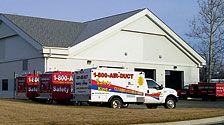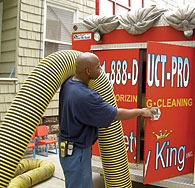
"Our history has taught us one thing for sure: We need to focus on doing work of the highest possible quality," said the founder of the Utica, Mich.-based duct cleaning business.
"We no longer try to compete with other providers on price alone. There are plenty of unlicensed, untrained, uncertified, unqualified providers fighting over that uninformed part of the market, because like attracts like.
"In our market there are now more than 200 companies that advertise air duct cleaning. This means we compete in a market in which most of our competitors advertise low prices, such as a ‘$38 Whole House Special' or ‘$6 per vent.' Can you spell rip-off?
"In addition, some heating contractors use air duct cleaning as a door opener or deal closer, always at a low price. But since it isn't their primary business, such providers very seldom can commit the resources needed for proper equipment, training, or oversight."
It's one reason why Palazzolo is such a believer in the National Air Duct Cleaners Association (NADCA), which has been trying to legitimize the industry in more ways than one. Among other goals, NADCA produces cleaning standards. Standard ARC 2005, for instance, spells out the technical requirements for true source-removal air duct cleaning, a standard which Palazzolo firmly believes in and follows.
"We prefer satisfying customers that require the absolute best," said Palazzolo. "We scrupulously follow NADCA Standard ARC 2005. I believe that customers who want that kind of work will find us.
"This has not always been an easy position to take. It has meant investing significant amounts of money in equipment, supplies, and technician training, and then waiting years for the return on investment. But make no mistake about it, return it has, and then some."
From a one-truck outfit in 1969, Palazzolo has created a 20-truck, $2.1 million-per-year business, which doubles as a duct cleaning school, too.
"Over the years, as better ways were devised to clean ductwork, and as cleaning equipment improved, it became more and more obvious how much dirt there actually was in ductwork," said Palazzolo.
"In an average home, the square footage of ductwork is roughly equal to the square footage of the smallest bedroom. We often suggest to our customers that they imagine that much space littered with dirt, dust, pet hair, and worse."

The Early Years
Palazzolo is almost embarrassed to relay how he started his career. It was in 1967 that a friend's mother offered him a job running an air duct cleaning truck for the family's heating company."That sounded all right by me, so I went out the next day with a jovial fellow named Bob who showed me their cleaning process," recalled Palazzolo.
"We drove a rusted-out rolling disgrace of a vacuum truck to our first job of the day. After un-loading a 200-foot section of 6-inch hose patched with several rolls of duct tape, we hooked the hose up to the vacuum nozzle on the truck and laid the other end next to the furnace blower in the basement.
"We shut off the pilot on the furnace and started up the truck vacuum. Because of the condition of the hose and the age and condition of the truck, the suction at the end of the hose that was near the furnace was virtually nonexistent. We headed upstairs to the living quarters where we proceeded to point an electric air blower at each register for 30 seconds.
This, we told the customer, pushed the dust and debris down to the vacuum hose where it was pulled out to the truck.
"We returned downstairs, blew some air in the blower compartment, relit the pilot and started the furnace. The last step in our customer-relations routine was to explain that the smell of burning dirt now in the air was normal (some dust burning off the heat exchanger, not to worry) and collect the money: $19.95 complete, cash or check, no credit. The vacuum hose was put back on the truck and off we went, repeating the process seven more times that day.

The young Palazzolo did eight jobs the next day by himself, and was back in the garage within nine hours. He was a good trainee. So good, in fact, that he started his own duct cleaning company two years later, using his first employer as a model.
"I purchased a used vacuum truck and charged a little less than my friend's company did.
I was sure they were making money hand over fist. I thought I would too. But, instead, what I got was a lesson I never forgot. I learned firsthand the law of cause and effect.
"Because I sent out the lowest price, I attracted the customer with the least amount of money. And because my customers were people with very little money, their furnaces were always falling apart in my untrained hands. Because I charged the least, I could not pay good wages and I couldn't properly maintain my trucks. I could not save a portion of the proceeds.
"Then again, what proceeds? I could not extend credit. I could not extend senior discounts. Because I was untrained, I sent out untrained technicians. Because I did not pay good wages, I attracted poor employees. Apparently, good employees demand good wages. Imagine that!"
Deep down Palazzolo said he knew his company was not sending much of quality out the door because not much good was coming back. He also had to overcome the fact that almost nobody had heard of air duct cleaning in the 1970s, other than the blow-and-go guys - whoever they were.

Forced To Change
Then one day Palazzolo overheard his newly hired sister/bookkeeper/best friend explain to a potential customer that, "her brother would never associate himself with anything but the best.""That started changing everything," he said. "I began to take heating and air conditioning classes at a local university. I visited a couple of vacuum truck manufacturers and made a few suggestions. I talked to hose manufacturers to explain what we needed. I went to see anybody that was even remotely connected with air duct cleaning in Michigan, Ohio, and Indiana. I even began to develop tools to improve our workmanship."
By this time, all of his trucks had onboard compressors, but he needed custom tools to make good use of them. He became a state-licensed mechanical contractor, as Michigan is one of five states that require a mechanical license to cut and reseal air ducts.
"Our performance was still not perfect, but we were so much better than our competition that the company name, Safety King, began growing quite a reputation," he said. "We started to train and consult to a few out-of-state firms. I no longer answered the phone or mangled the books. Sisters are great!"
In the late 1980s, Palazzolo heard about a get-together in Kansas City, Mo., for a few air duct cleaners, scheduled by a West Coast vacuum-truck manufacturer. As fortune would have it, he noticed in the local newspaper that Southwest Airlines was having a sale: Detroit to Kansas City, $19.95.
"This was so inexpensive that I invited a friend-employee and his wife to come along," he said. "I called the manufacturer and wrangled an invitation for us, and I went into that meeting ready to ask questions and hoping to learn."
Palazzolo left that meeting as a board member and first membership director of a new organization: NADCA.
"Two years later, we had 175 member companies and I was serving as president," he said.
In his eyes, one of the best results from the formation of NADCA turned out to be the annual convention, which gave manufacturers and dealers a forum in which to introduce new and better duct cleaning equipment.
"Each year we saw bigger, more powerful vacuum trucks, outdoor portable vacuums, and stronger portables with HEPA filtration for easy transportation in high-rise buildings. At each convention, equipment providers offered better whips, spinning brushes, poles and new air nozzles that we all could use to upgrade the work product we were providing."
NADCA also began a nationwide technician certification program to further improve cleaning procedures and improve the public's perception of air duct cleaners.

It's A Son-Filled Future
Palazzolo's oldest son, Michael James, began working for his father at the age of 12. After he graduated from the University of Michigan, he came to work for his father full time."He introduced truck logs and spot truck inspections," said the elder Palazzolo. "He once called me up at 10 p.m. to explain that company policy was to fill the vehicle gas tank upon return, which I had not done. He said, ‘If you don't follow the rules, who will?'
"I got up and went over and filled that truck."
Pretty soon Safety King, thanks to Michael James, had instant communication with wireless phones and technology. He made blower pulling and coil cleaning mandatory on every job. He began company training sessions twice monthly, technician meetings weekly, and safety equipment inspection twice weekly.

Another son, Marcus, shares marketing duties and handles the convention and home-show circuit.
"Television and radio stations regularly broadcast our jingle and phone number."
Safety King now has an additional business in providing the use of its toll-free number to other duct cleaning companies around the country. It has a commercial division which has its own equipment, and everything is housed in the brand new, 10,000-square-foot garage Safety King built last year. It sits right next to the new 4,200-square-foot corporate office building that opened this year.
"We now have 17 NADCA-certified technicians on staff," said Palazzolo. "Everything is shiny clean. We have a huge Web presence. We provide technician training that has attracted attendees from as far away as Singapore, Australia, and the Virgin Islands. We have trained hundreds of successful firms in administration and marketing techniques."
In the end, he is trying to bring respectability to the air duct cleaning business.
"Air ducts are like the veins and arteries in your body," he explained. "Just as your arteries deliver freshly oxygenated blood to different parts of the body, air ducts carry heated or cooled air to different parts of the home or office."
He estimated a brand new 1,500-square-foot ranch home yields an average of 17 pounds of dust and construction debris. He mentioned that the air ducts in older homes typically conceal a germ-laden mix of dog hair, cat fur, dead skin, and bug carcasses.
"When the blower turns on, the occupants breathe this stuff," he summarized. "For many people, air duct cleaning is a health issue."
Sidebar: You'll Never Know What You'll Find
Cleaning ducts can be entertaining. Just ask Michael Palazzolo. "We find a lot of things in ductwork that we don't expect," said the CEO of Safety King."Over the years we've turned up soiled diapers; two diamond rings; magazines hidden away by teenage boys; diaries of young girls; a pistol; hypodermic needles; and immigration papers."
And money.
"The money thing is pretty amazing," he agreed. "There have been pesos, rubles, yen, kroner, deutschmarks, lira, confederate dollars, and more than a trillion dollars in monopoly money. Once we found $8,000 in coins."
Paper cups, beer cans, and the occasional builder's lunch are commonplace.
"My personal favorite is the clarinet, still in its case," he said. "The homeowner couldn't wait to confront her son with the long-lost, perfectly preserved instrument. She just kept mumbling, ‘All those payments...'"
- Mark Skaer
Publication date: 09/05/2005



